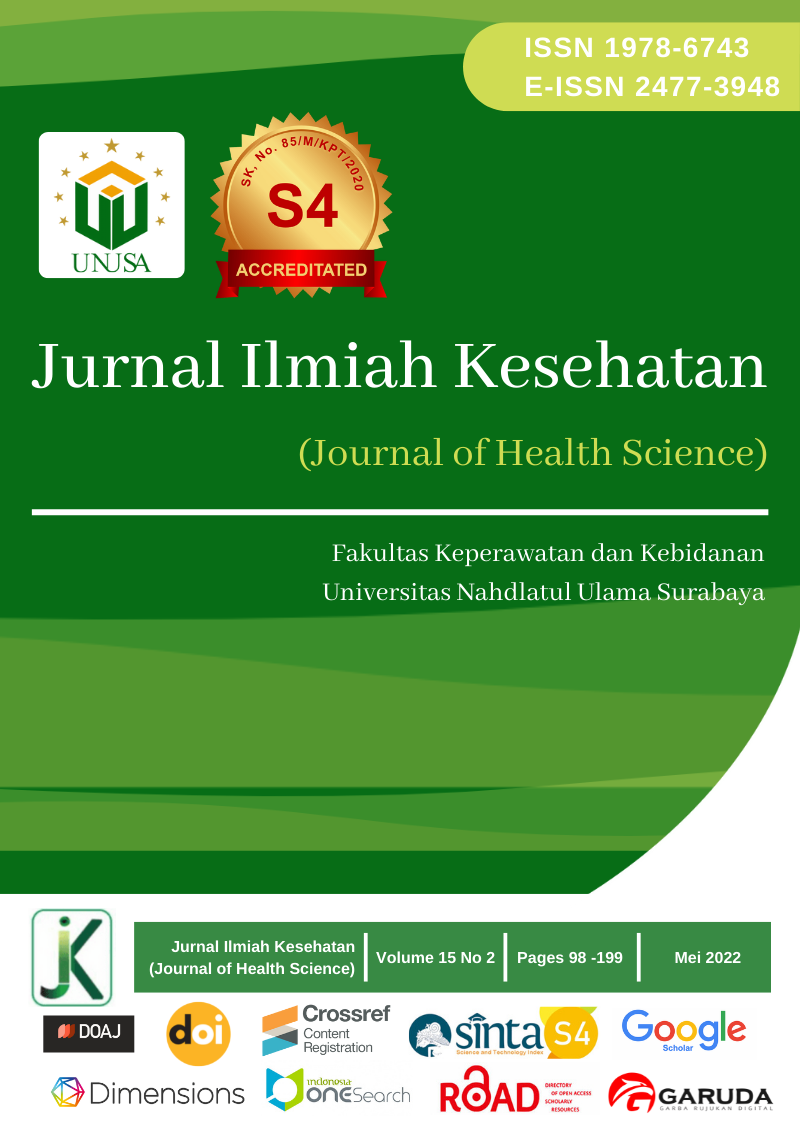The Benefits and Risks of Spraying Disinfectants in The Public Spaces During The Coronavirus Disease 2019 (Covid-19) Pandemic: A Literature Review Stud
Main Article Content
Abstract
Coronavirus Disease 2019 (COVID-19) spreads quickly through droplets from the patient's nose or mouth, falls on objects around them, and becomes the transmission source for others. Therefore, the community prevents COVID-19 transmission by spraying disinfectants in the environment and using sanitary booths for humans despite not being recommended by the Indonesian government and WHO because it's a health risk. This study analyzes the benefits and risks of spraying disinfectants in public spaces during the Coronavirus Disease 2019 pandemic. This study used six database sources: Pubmed ScienceDirect, ResearchGate, Google Scholar, Pusat Penelitian dan Pengembangan Upaya Kesehatan Masyarakat (Puslitbang Ukesmas), and Elsevier during 2016-2021, with inclusion and exclusion criteria selected by the authors on PRISMA flow diagram. There were 15 articles matching those criteria. Nine concluded that spraying disinfectants in the community could prevent the spread of COVID-19. In addition, it was efficient for surface objects and large areas. Furthermore, ≤ 200 ppm chlorine-based disinfectants and 15% alcohol-based were safe to use. Meanwhile, six articles revealed a risk of spraying disinfectants due to improper disinfectants mixing and spraying disinfectants on food and the body. In conclusion, spraying disinfectants in the community is safe for the eyes, respiratory tract, and skin of humans. It also can prevent the spread of Coronavirus Disease 2019 when the method, material, and usage are appropriate.
Downloads
Article Details
Copyright (c) 2022 Pramono Pramono, Indasah Indasah

This work is licensed under a Creative Commons Attribution-ShareAlike 4.0 International License.
References
Abo, S. M. C. and Smith, S. R. (2020) ‘Is a COVID-19 vaccine likely to make things worse?’, Vaccines,
PRAMONO / JURNAL OF HEALTH SCIENCE – VOLUME 15 NOMOR 02 (2022) E-ISSN: 2477-3948
https://doi.org/10.33086/jhs.v15i02.2658 Pramono - The Benefits and Risks of Spraying Disinfectants in The Public Spaces
During the Coronavirus Disease 2019 (Covid-19) Pandemic: A Literature Review
Study
(4), pp. 1–13. doi: 10.3390/vaccines8040761.
Ahmad Zulfikri1, Y. K. A. and 1, 2Fakultas (2020) ‘Dampak Cairan Disinfektan Terhadap Kulit Tim Penyemprot Gugus Tugas COVID-19 Kota Binjai. Jurnal Menara Medika’, Jurnal Menara Medika, 2(2), pp. 119–127.
Aini Tartinia (2020) ‘BERITA PENYEMPROTAN DI JAKARTA TIMUR Sudin Damkar Jaktim Semprot Disinfektan di 8.137 Lokasi, Home’, 21(1), pp. 1–9.
Ardhi, M. R. H. dan Y. (2021) ‘Penyemprotan Disinfektan di Jalanan Jakarta’, p. 2021.
Athena, A., Laelasari, E. and Puspita, T. (2020) ‘Pelaksanaan Disinfeksi Dalam Pencegahan Penularan Covid-19 Dan Potensi Risiko Terhadap Kesehatan Di Indonesia’, Jurnal Ekologi Kesehatan, 19(1), pp. 1–20. doi: 10.22435/jek.v19i1.3146.
Cadnum, J. L. et al. (2020) ‘Evaluation of an electrostatic spray disinfectant technology for rapid decontamination of portable equipment and large open areas in the era of SARS-CoV-2 Jennifer’, (January).
Casey, M. L. et al. (2017) ‘Health problems and disinfectant product exposure among staff at a large multispecialty hospital’, American Journal of Infection Control, 45(10), pp. 1133–1138. doi: 10.1016/j.ajic.2017.04.003.
Chang, A. et al. (2020) ‘Cleaning and Disinfectant Chemical Exposures and Temporal Associations with COVID-19 — National Poison Data System, United States, January 1, 2020–March 31, 2020’, MMWR. Morbidity and Mortality Weekly Report, 69(16), pp. 496–498. doi: 10.15585/mmwr.mm6916e1.
Chui, J. et al. (2021) ‘Environmental Contamination of SARS-CoV-2 in a Non-Healthcare Setting’.
Dindarloo, K. et al. (2020) ‘Pattern of disinfectants use and their adverse effects on the consumers after COVID-19 outbreak’, Journal of Environmental Health Science and Engineering, 18(2), pp. 1301–1310. doi: 10.1007/s40201-020-00548-y.
Eslami, H. et al. (2020) ‘How Alcoholic Disinfectants Affect Coronavirus Model Membranes: Membrane Fluidity, Permeability, and Disintegration’, Journal of Physical Chemistry B, 124(46), pp. 10374–10385. doi: 10.1021/acs.jpcb.0c08296.
Gharpure, R. et al. (2020) ‘Knowledge and Practices Regarding Safe Household Cleaning and Disinfection for COVID-19 Prevention — United States, May 2020’, MMWR. Morbidity and Mortality Weekly Report, 69(23), pp. 705–709. doi: 10.15585/mmwr.mm6923e2.
Kemenkes (2020) ‘Penggunaan Bilik Desinfeksi Dalam Rangka Pencegahan Penularan Covid-19’, mentri kesehatan RI.
Luo, N. (2020) ‘Stop COVID-19 with Air Spray of a Hypochlorite Solution Defeat Coronavirus with Air Spray of Bleach : Hypochlorite Aerosol Stops the Airborne Transmission of COVID-19’, (March), pp. 2–3. doi: 10.13140/RG.2.2.36028.39041.
Ma, J. W. et al. (2017) ‘Efficacy and safety evaluation of a chlorine dioxide solution’, International Journal of Environmental Research and Public Health, 14(3). doi: 10.3390/ijerph14030329.
Maharani, E. N. and Hendrasarie, N. (2020) ‘Efektivitas Desinfektan Aerosol Terhadap Pengurangan Bakteri-Jamur dan Dampaknya Terhadap Kulit Manusia’, pp. 148–154.
Nabia, G. et al. (2020) ‘Massive use of disinfectants against COVID-19 poses potential risks to urban wildlife’, (January).
Nafilah, Z. A. and Muflihah, . (2020) ‘Langkah Taktis Pencegahan Covid-19 di Desa Lowayu Kecamatan
PRAMONO / JURNAL OF HEALTH SCIENCE – VOLUME 15 NOMOR 02 (2022) E-ISSN: 2477-3948
https://doi.org/10.33086/jhs.v15i02.2658 Pramono - The Benefits and Risks of Spraying Disinfectants in The Public Spaces
During the Coronavirus Disease 2019 (Covid-19) Pandemic: A Literature Review
Study
Dukun Kabupaten Gresik’, Prosiding Penelitian dan Pengabdian kepada Masyarakat, 7(2), p. 360. doi: 10.24198/jppm.v7i2.28821.
Nidom, R. V. et al. (2020) ‘Investigation of the D614G mutation and antibody-dependent enhancement sequences in indonesian SARS-CoV-2 isolates and comparison to southeast Asian isolates’, Systematic Reviews in Pharmacy, 11(8), pp. 203–213. doi: 10.31838/srp.2020.8.30.
Prof. Dr. Nursalam, M. N. (Hons) D. (2020) Penulisan Literature Review dan Systematic Review pada Pendidikan Kesehatan (Contoh). Surabaya: Fak Keperawatan Univ Airlangga.
Rabby, M. I. I. et al. (2020) ‘Disinfection booth: blessing or curse for spreading of COVID-19 in Bangladesh’, Canadian Journal of Public Health, 111(5), pp. 660–662. doi: 10.17269/s41997-020-00402-6.
Wardani, E. M. et al. (2022) ‘Clinical Manifestations of COVID-19 Patients with Comorbid and Non-comorbid at Dr . Soetomo Hospital , Surabaya’, Open Access Macedonian Journal of Medical Sciences, 10(G-Nursing), pp. 330–334. doi: https://doi.org/10.3889/oamjms.2022.7582.
Weinmann, T. et al. (2017) ‘Association of household cleaning agents and disinfectants with asthma in young German adults’, Occupational and Environmental Medicine, 74(9), pp. 684–690. doi: 10.1136/oemed-2016-104086.
WHO (2020) Cleaning and Disinfection of Environmental Surfaces in the context of COVID-19, WHO.
Wiemken, T. L. et al. (2016) ‘Disinfectant sprays versus wipes: Applications in behavioral health’, American Journal





